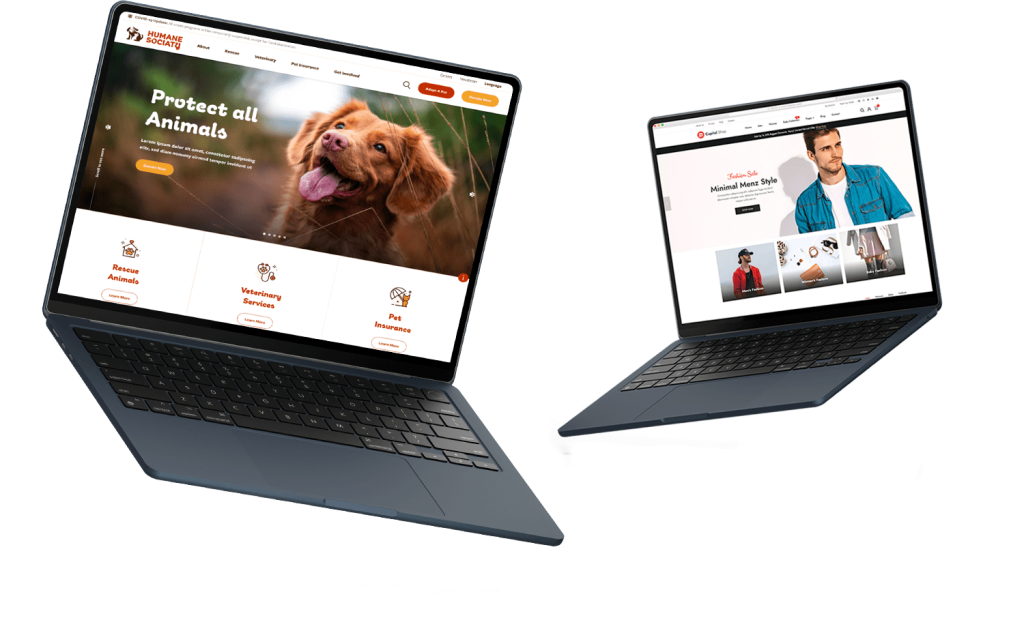Here’s Why Responsive Web Design Is More Than Just Appearance — It’s the Backbone of a Great User Experience
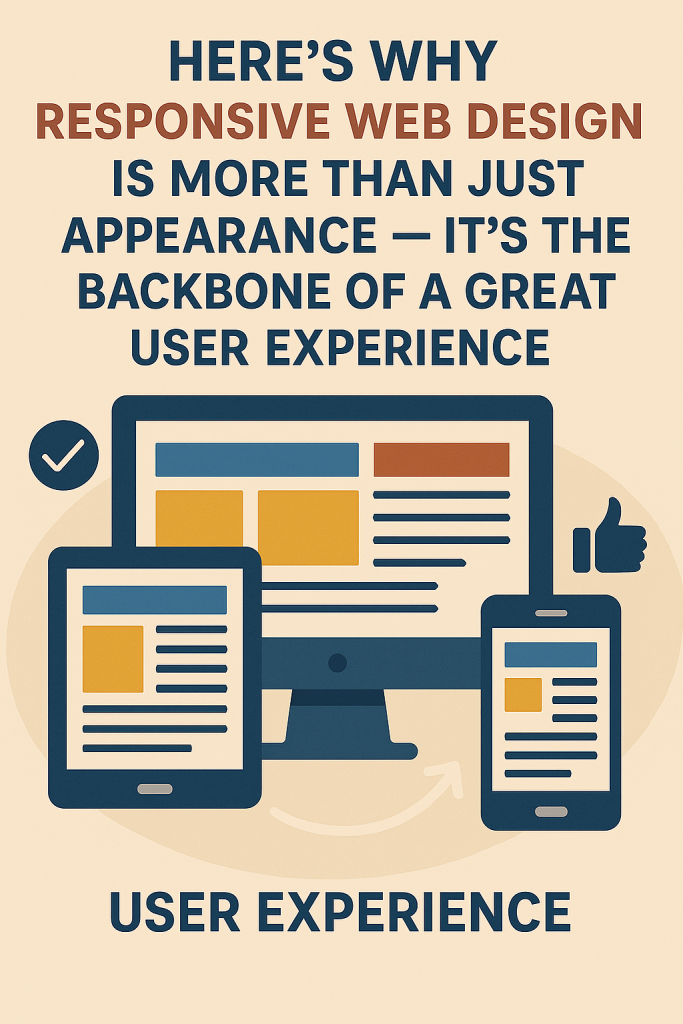
Responsive design has become a buzzword in web development, but it’s far more than a trend. In 2025, with digital engagement surging and user expectations rising, a responsive website design isn’t optional—it’s essential. Businesses that prioritize adaptable and user-centric designs see higher engagement, better rankings through SEO optimization services, and more conversions. What Is Responsive Web Design? Responsive website design is a result-driven design approach where websites adapt fluidly to different screen sizes, resolutions, and orientations. Whether it’s a desktop, tablet, or smartphone, responsive sites ensure a consistent and optimized user experience. Rather than building separate websites for diversified devices, responsive design uses CSS media queries, fluid grids, and flexible images to create one website that responds to the environment in which it’s viewed. This flexibility makes development and maintenance more efficient in the long run. The SEO Benefits of Going Responsive Enhanced Mobile-Friendliness Google prioritizes mobile-first indexing. This means that Google predominantly uses the mobile version of content for indexing and ranking. If your site isn’t mobile-friendly, it’s already at a ranking disadvantage. Lower Bounce Rates When users opens a website easily on any device, they’re more likely to stay. This lowers bounce rates, an important factor in search engine rankings. If users leave immediately because your site looks broken or hard to use, Google takes note. Improved Page Speed Responsive design encourages better optimization of images and elements for all devices, contributing to faster load times—a critical SEO optimization services factor. Fast websites keep users engaged and drive better engagement metrics, which Google rewards. How Responsive Design Enhances UX Seamless Navigation Users expect websites to function intuitively across devices. Responsive layouts ensure navigation menus, buttons, and CTAs are accessible and easy to use. A frustrating mobile experience can be a deal-breaker for visitors. Consistent Branding Maintaining visual consistency across platforms builds brand trust. Responsive design ensures that fonts, colors, and visuals remain uniform, reinforcing your brand identity whether viewed on a smartphone or widescreen monitor. Accessibility and Inclusivity A responsive site can be more accessible for users with disabilities, contributing to improved usability and broader reach. Real-World Example: Case Study of Improved Metrics A recent Speed Dot 360 project for a mid-sized ecommerce client saw a 35% increase in mobile conversions and a 40% decrease in bounce rate after implementing a fully responsive website design. Additionally, the client’s Google PageSpeed score jumped by 25 points within three weeks. “We never realized how many potential customers we were losing on mobile until we upgraded to a responsive layout. The improvement was instant.” — Client Testimonial Key Elements of a Responsive Website The Role of a UI/UX Design Agency Professional UI/UX design agency teams bring deep knowledge of user behavior, enabling data-driven design decisions. At Speed Dot 360, we integrate: All these help us create experiences that not only look great but convert better. Emerging Trends in Responsive Design (2025 and Beyond) Industry Perspectives: What Experts Are Saying According to a 2024 report by Adobe, 73% of users said they are more likely to return to a mobile-friendly website design. Google’s own research shows that 61% of users are unlikely to return to a mobile site they had trouble accessing. “Responsive design is not just a technical requirement—it’s a brand’s handshake with its users.” — UX Matters Magazine Internal Linking Strategy Responsive website design pages should include smart internal links to: This boosts SEO and enhances the user journey. Final Thoughts Responsive design is no longer just about accommodating mobile users—it’s about delivering seamless, fast, and enjoyable digital experiences across the board. It impacts SEO, brand perception, conversions, and user trust. If your site isn’t responsive in 2025, you’re not just behind—you’re invisible. Partner with Speed Dot 360 to audit, upgrade, and future-proof your website. Because first impressions now happen in the palm of your customer’s hand.
Plan Your Website Structure With Speed Dot 360 | A Step-by-Step Guide to Boost UX and SEO
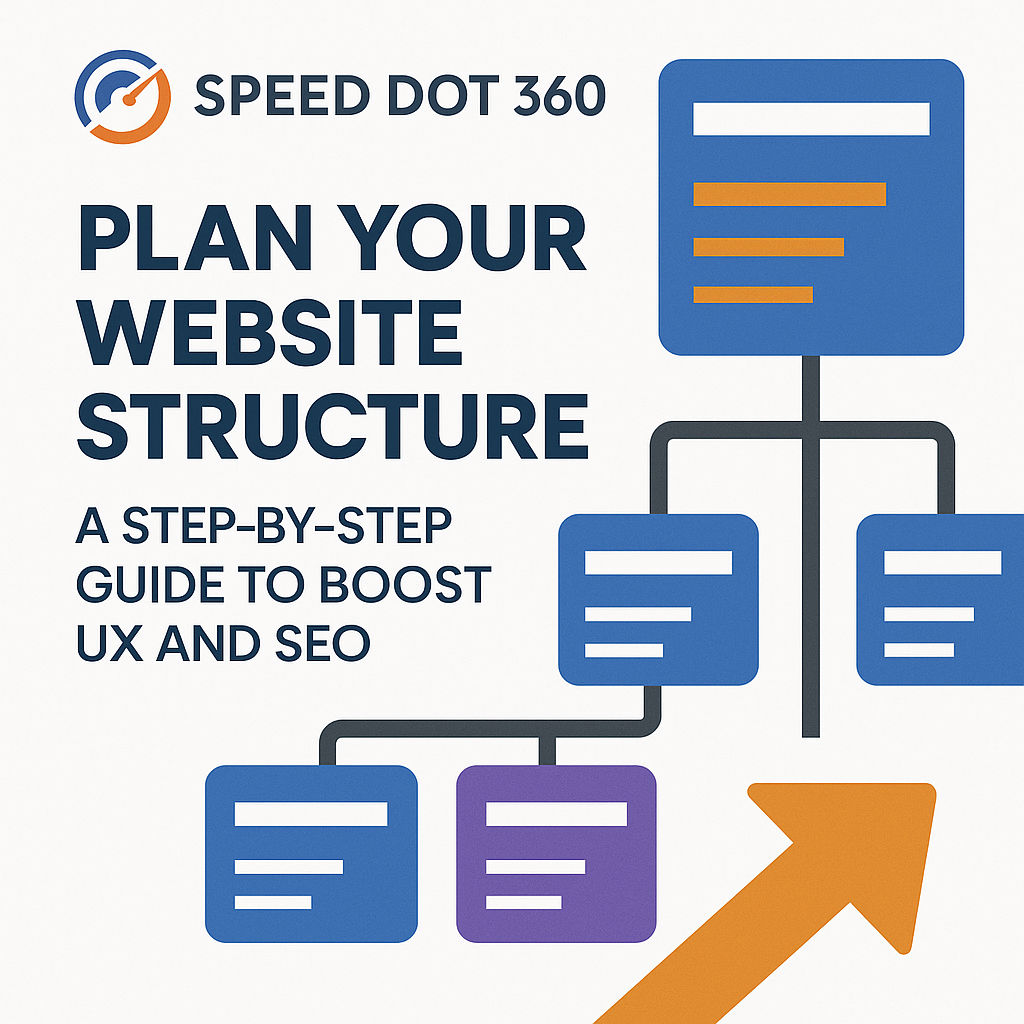
In today’s digital-first world, a website that looks good but doesn’t perform is a liability. Many businesses invest in sleek designs or flashy visuals but forget about one of the most crucial elements of a high-performing website—its structure. If your content is hard to find, navigation feels clunky, or pages are buried beneath layers of poor hierarchy, both your visitors and search engines will leave. This is where Speed Dot 360 helps transform confusion into clarity. Backed by years of experience in custom web development and responsive website design, we’ve developed a tried-and-true method to structure websites for both humans and algorithms. In this step-by-step guide, we walk you through the foundational process of building a site that is intuitive, scalable, SEO-friendly, and designed with the user in mind. Step 1: Begin With Business and User Alignment Before a single wireframe is built or a sitemap is drawn, we start by understanding two key things: your business goals and your audience’s expectations. It sounds basic, but it’s often overlooked. Are you aiming to generate leads, showcase a portfolio, or build an ecommerce platform? Knowing this determines how your homepage, menus, and landing pages are prioritized. Likewise, your audience’s journey on the site should feel logical and seamless. A visitor looking for pricing shouldn’t have to dig through five pages. That’s why our process at Speed Dot 360 always starts with user-first thinking—laying the foundation for a structure that feels natural from the first click. Step 2: Design the Hierarchy Intentionally Think of your site as a pyramid. At the top is your homepage, and beneath it are the core content categories, followed by subcategories and supporting pages. But a pyramid isn’t just about shape—it’s about clarity. Search engines, especially Google, prefer flat site structures where most pages are accessible within a few clicks. Our team helps streamline your architecture so your most important content is never too far away—improving both crawlability and user experience. Rather than overcomplicating with endless submenus and deep layers, we organize your content into clear categories that are easy to navigate, even on a mobile device—thanks to our focus on mobile-friendly website design. Step 3: Navigation That Guides and Converts Navigation is more than just a menu. It’s your website’s GPS. Poor navigation is one of the fastest ways to lose a visitor, and it’s a common cause of high bounce rates. We build navigation systems that align with your sitemap. Whether it’s a top-level nav bar, a sticky menu, or contextual internal links within the content, our focus is on guiding users to the right destination with minimal friction. Instead of relying on dropdown after dropdown, we focus on clarity: simplified labels, prioritized links, and smooth mobile interactions—key ingredients in responsive website design that keep visitors engaged on every screen. Step 4: URLs That Make Sense (To Users and Search Engines) Your website’s URLs are its street addresses. A clean, keyword-friendly URL structure makes a huge difference in SEO rankings and user trust. Rather than auto-generated slugs like /page?id=928, we implement semantic URLs such as /services/custom-web-development. Not only are they effortless for search engines to crawl, but they’re also more intuitive for users to remember and share. At Speed Dot 360, our developers integrate this during the build phase, ensuring every URL works with your content hierarchy, not against it. Step 5: Build for Mobile From Day One With mobile traffic making up over 60% of total web visits globally, ignoring the mobile experience isn’t an option—it’s a mistake. At Speed Dot 360, mobile-friendly website design is the default, not the afterthought. Your site structure must hold up just as well on a smartphone as it does on a widescreen monitor. That means reducing menu clutter, optimizing tap areas, streamlining loading times, and prioritizing thumb-friendly interactions. Whether your users are browsing on the go or searching for your contact info before booking a service, our team ensures your mobile structure delivers a consistently excellent experience. Step 6: Connect Your Content Strategically Internal linking is the secret weapon of site architecture. It’s what keeps users exploring your site and allows Google’s bots to understand the relationship between your pages. Rather than stuffing every blog post with random links, we craft strategic pathways between related content—especially between cornerstone pages and supporting blog entries. This not only helps with SEO but encourages deeper engagement from visitors who want more. When paired with a strong content plan, this structure also helps build authority around topics relevant to your niche. Step 7: Use Real-Time Data to Refine the Flow A well-structured website doesn’t just happen once and stay that way forever—it evolves. Post-launch, we use tools like Google Analytics and Hotjar to monitor how users move through your site. Where do they click? Where do they drop off? Are they reaching key conversion points? These insights allow our team to make informed updates, test new navigation strategies, or adjust the layout for better flow. As a performance-driven UI/UX design agency, we don’t guess—we optimize based on real behavior. Step 8: SEO-First, Always While UX is vital, structure without SEO is like building a road with no signs. That’s why our structures are SEO-first from the blueprint. We help ensure each page is indexed properly, structured for relevance, and designed to answer searcher intent. This includes schema markup, logical heading hierarchies, optimized category pages, and XML sitemaps that help search engines crawl effectively. Good structure supports great SEO. It’s not just about showing up—it’s about staying visible. Why Partner with Speed Dot 360? Speed Dot 360 isn’t just about building websites—it’s about engineering a digital ecosystem. From smart information architecture to intuitive flow, from clean code to conversion-ready layouts, we blend custom web development with deep UX insight. Whether you’re launching a new business, scaling an enterprise site, or revamping your current structure, we help you build something that grows with your goals—and your users. Conclusion Your website’s structure is more than a backend consideration—it’s a frontline experience that impacts
Is it Worth It? How to Evaluate the Success of Your Website Redesign
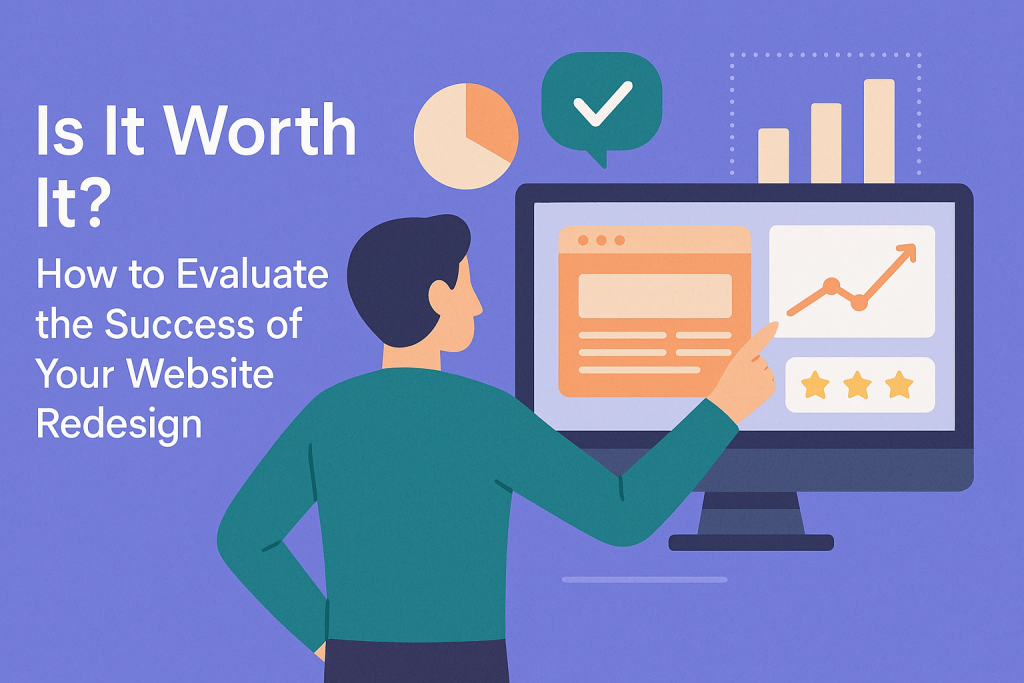
You’ve invested time, energy, and capital into website redesign services, maybe even revamped your brand entirely. But now that your new site is live—what’s next? Was the investment worth it? A website redesign is more than a visual facelift. It’s a strategic move aimed at boosting performance, enhancing user experience, and increasing conversions. However, to ensure you’ve actually moved the needle, you must measure success through clear, actionable KPIs. In this blog, we’ll explore the most effective ways to evaluate your redesign and determine whether it delivered true ROI—or just pretty pixels. 1. Set Clear Goals Before You Launch The first step to evaluating success is knowing what you’re measuring against. Every redesign should be aligned with specific business objectives. Common Goals Include: If your redesign didn’t begin with goal-setting, start now by defining what “success” looks like for your brand. 2. User Experience Metrics: Are Visitors Enjoying the New Design? User Experience (UX) is at the forefront of every effective redesign. Good design guides users toward actions—great design makes those actions frictionless. Key UX KPIs: If these metrics improved, then your custom web development and UX decisions are paying off. 3. Conversion Rates: Is the New Design Driving Action? The primary goal for most websites is to convert visitors—whether that means purchases, sign-ups, downloads, or form submissions. Comparing pre- and post-redesign conversion rates is critical. Metrics to Watch: Tip: Use A/B testing tools like Google Optimize to experiment with CTA placements, layouts, and messaging post-redesign. 4. SEO Performance: Did Your Rankings Survive the Makeover? A poorly executed redesign can sabotage search engine visibility. A well-executed one will maintain or even enhance it. SEO Metrics to Evaluate: Working with a developer skilled in responsive website design ensures mobile-first optimization, which is now critical for Google rankings. 5. Mobile Responsiveness: Is It Truly Mobile-First? With more than half of global traffic coming from mobile, your redesign must excel on smartphones and tablets. Test With: If mobile bounce rates have dropped and engagement has increased, your responsive website design is doing its job. 6. Website Speed: Faster = Better Speed kills—especially slow websites. Site performance plays a major role in both UX and SEO. Use Tools Like: Improve By: If your bounce rate is dropping and conversion rate is rising, performance upgrades from your website redesign services are likely a key factor. 7. Heatmaps and Session Recordings: Watch Real Users in Action Numbers are valuable, but behavioral tools offer goldmines of insight. Tools to Use: Watch how users navigate, where they get stuck, and where they click. These qualitative insights validate your redesign decisions—or highlight where tweaks are needed. 8. Accessibility Improvements: Inclusive Design = Better Results Designing for accessibility not only expands your audience—it often leads to better UX for everyone. Evaluate: Accessibility improvements can indirectly impact bounce rate, engagement, and conversion rates—especially on forms and navigation menus. 9. Technical Health: Is Your Backend Built to Last? A polished front end needs a robust back end. Quality custom web development ensures fast load times, fewer errors, and a smoother user journey. Key Checks: If your site is throwing fewer errors and your time-to-first-byte (TTFB) is faster, the backend overhaul was a win. 10. ROI: The Ultimate Success Indicator All your metrics feed into one final judgment: return on investment. Did the money you spent on redesign actually increase revenue or leads? Formula:ROI = (Net Profit from Redesign – Cost of Redesign) / Cost of Redesign x 100 Track long-term benefits like: A high ROI means your website redesign services investment was absolutely worth it. 11. Stakeholder and Customer Feedback: Gut-Checks Matter Too Don’t ignore qualitative feedback. What do customers, clients, and internal teams say about the new design? Collect Feedback From: Sometimes the clearest signals of success come from the people actually using your site. Measure What Matters, Then Iterate The only way to know if your redesign was “worth it” is by measuring real results. Evaluate success based on a mix of hard data and human feedback. Look beyond the aesthetics and dive deep into UX, SEO, performance, and ROI. At SpeedDot360, our website redesign services, responsive website design, and custom web development ensure your digital investment pays dividends. We don’t just design websites—we build platforms that drive growth.
Revolutionizing Social Media Advertising Trends of 2025
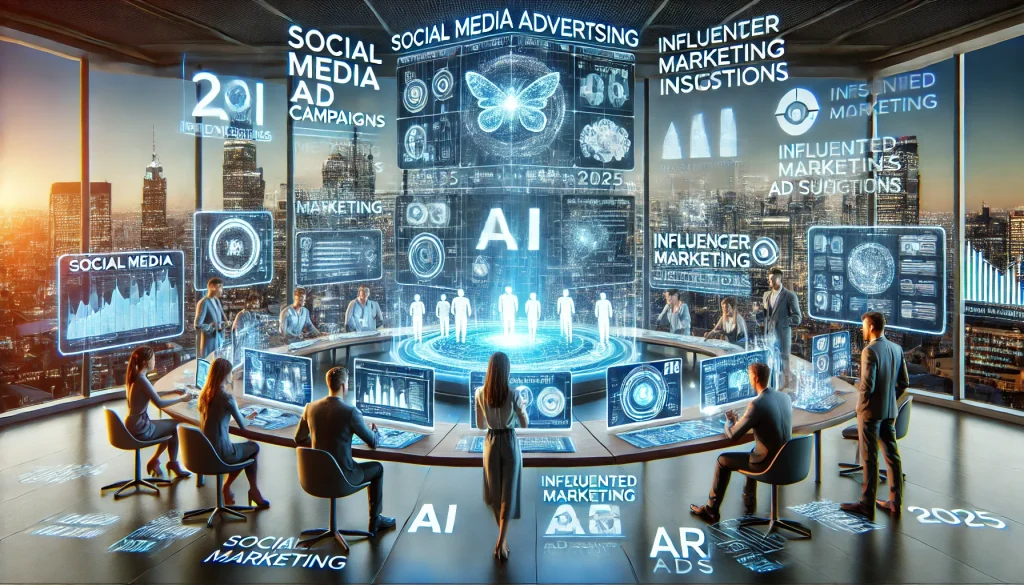
Social media advertising is evolving faster than ever, with platforms introducing innovative features, AI-driven insights, and advanced targeting capabilities. As businesses strive to stay ahead, mastering the latest social media strategy development trends will be crucial for success in 2025. In this blog, we’ll explore the biggest social media advertising trends shaping 2025 and how businesses can optimize their digital marketing strategies. AI and Automation: The Future of Social Media Advertising AI is transforming paid social media advertising, enabling businesses to optimize targeting, content creation, and audience engagement. Rather than relying on traditional methods, AI-driven automation now personalizes ad experiences, predicts user behavior, and streamlines the ad placement process. Artificial Intelligence (AI) is revolutionizing paid social media advertising by enhancing targeting accuracy, optimizing ad delivery, and personalizing user experiences. Key AI-driven trends include: Automated Ad Creation: AI-generated ad copies and visuals tailored to audience preferences. Predictive Analytics: AI forecasts user behavior, improving ad targeting and conversions. Chatbot Integration: AI-powered chatbots facilitate instant interactions and customer engagement. Brands that integrate AI into their advertising strategies will have a competitive edge by improving efficiency and audience engagement. Video Content Continues to Dominate Short-form videos, interactive live streams, and immersive content remain at the front of social media strategy development. Platforms like Instagram Reels, TikTok, and YouTube Shorts provide businesses with an engaging way to showcase products, tell brand stories, and foster audience interaction. With platforms like TikTok, Instagram Reels, and YouTube Shorts leading the way, short-form videos continue to dominate social media management strategies. In 2025, businesses should focus on: Engaging, high-quality content that captures attention within the first few seconds. Shoppable videos that permit users to purchase directly from the platform. Interactive elements like polls, Q&A, and live shopping events to enhance engagement. Short-form videos provide an authentic way for brands to collaborate with their audience and drive conversions. The Emergence of AR, VR, and the Metaverse With the growing popularity of AR and VR experiences, brands are using these technologies to create interactive advertising campaigns. From virtual try-ons to immersive shopping experiences, AR and VR are redefining consumer engagement on social media platforms. AR and VR are transforming how brands interact with consumers, making advertising more immersive and interactive. Key trends include: AR Filters & Try-On Features: Users can visualize products before purchasing (e.g., virtual makeup try-ons). VR Shopping Experiences: Brands create virtual storefronts for customers to discover products in a digital space. Interactive 3D Ads: Engaging ad formats that enhance user experiences on platforms like Instagram and Snapchat. As AR/VR adoption increases, businesses incorporating these technologies into their advertising strategies will see higher engagement and conversion rates. Hyper-Personalization in Advertising Personalized advertising will reach new heights in 2025, driven by AI and data analytics. Key developments include: Dynamic Content Customization: Ads tailored to individual preferences, behaviors, and demographics. User-Generated Content Integration: Leveraging customer testimonials and influencer content for more authentic promotions. Predictive Retargeting: AI analyzes browsing patterns to serve hyper-relevant ads. Consumers now expect highly personalized experiences, making this trend essential for boosting engagement and ROI. Social Commerce Becomes the New Norm The incorporation of e-commerce into social media platforms is revolutionizing online shopping. Platforms like Instagram, TikTok, and Facebook allow users to browse and purchase products seamlessly, making social media management a key component of sales-driven strategies. Social commerce is redefining online shopping by merging e-commerce with social media platforms. Notable trends include: One-Click Purchases: Seamless checkout experiences within social apps. Livestream Shopping: Real-time product demonstrations with instant purchasing options. AI-Powered Recommendations: Personalized product suggestions in accordance with user interactions. Brands leveraging Instagram marketing services and Facebook Shops will capitalize on social commerce trends in 2025. Increased Focus on Privacy and Ethical Advertising With rising concerns over data privacy, brands must adapt to new regulations and ethical advertising standards. Important developments include: Cookie-Less Targeting: Shifting from third-party cookies to first-party data and contextual targeting. Transparent Advertising Practices: Clearly communicating data usage policies to users. Ethical AI in Advertising: Ensuring AI-generated content is unbiased and respects user privacy. Brands prioritizing privacy-compliant advertising strategies will build trust and maintain customer loyalty. Redefining Influencer Marketing in 2025 Influencer partnerships are evolving beyond traditional collaborations. Brands now prioritize micro-influencers, AI-driven influencer selection, and performance-based contracts to ensure more meaningful engagement and tangible ROI. Influencer marketing continues to grow, but in 2025, authenticity and niche collaborations will take center stage. Key shifts include: Micro and Nano Influencers: Smaller influencers with highly engaged audiences drive more authentic interactions. AI-Powered Influencer Matching: AI tools connect brands with the most suitable influencers. Performance-Based Partnerships: Brands focus on measurable ROI rather than follower count. Businesses that refine their influencer marketing strategies will see higher engagement and conversion rates. Audio Advertising on Social Media With the dynamic surge of podcasts and audio-based platforms, social media audio advertising is gaining traction. Popular trends include: Voice Search Optimization: Ads optimized for voice search queries. Interactive Audio Ads: Engaging audio experiences with call-to-action prompts. Podcast Sponsorships: Brands collaborating with podcasters to reach niche audiences. Incorporating audio ads into social media strategy development ensures a well-rounded marketing approach in 2025. Cross-Platform Integration As users engage with multiple platforms, brands need a cohesive cross-platform advertising strategy. Key considerations include: Consistent Branding Across Channels: Unified messaging across Facebook, Instagram, TikTok, and LinkedIn. Omnichannel Marketing Strategies: Seamless experiences across social media, email, and websites. Automated Content Scheduling: AI-powered scheduling tools for optimized posting times. Cross-platform integration enhances brand visibility and strengthens audience engagement. Diversification of Social Media Ad Platforms While Facebook remains a powerful advertising channel, brands are shifting towards a multi-platform approach, investing in LinkedIn ads for B2B marketing, TikTok for younger audiences, and emerging social networks for niche markets. Facebook remains a leading force in social media advertising, but platforms like TikTok, LinkedIn, and emerging networks are reshaping digital marketing. Future trends include: AI-Powered Facebook Ad Optimization: Automated bidding and audience segmentation. LinkedIn B2B Advertising Growth: Increased investments in professional networking ads. TikTok’s Continued Expansion: Short-form video advertising innovations. Brands that diversify
UI/UX Trends That Are Already Shaping the Web in 2025
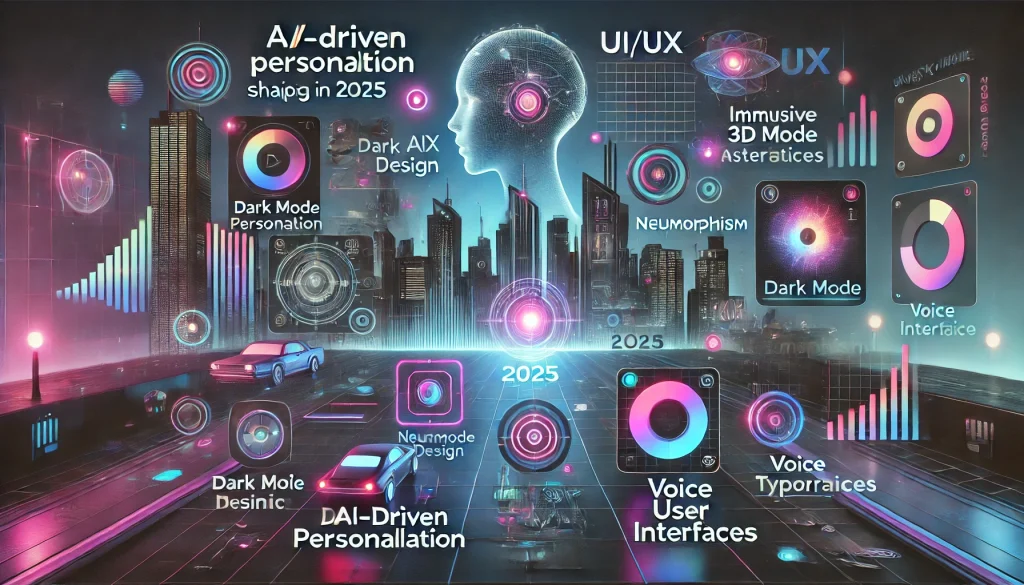
As we step into 2025, UI/UX design agency experts are witnessing rapid transformations in digital experiences. With the growing importance of user-centric designs, brands are focusing on creating intuitive, immersive, and aesthetically appealing interfaces. The integration of AI, immersive technologies, and personalization is redefining how users interact with websites and applications. In this blog, we explore the top UI/UX trends that are already shaping the web in 2025 and how they can elevate your digital presence. AI-Powered Personalization Artificial intelligence (AI) leads the charge of UI/UX innovation, allowing websites and apps to adapt to individual user behaviors. Dynamic UI Adjustments: AI-powered interfaces can modify layouts, colors, and content based on user preferences. Predictive User Experience: Machine learning anticipates user needs, offering personalized recommendations and automating interactions. Conversational AI: AI-driven chatbots and virtual assistants provide instant responses, enhancing engagement and user satisfaction. Personalization powered by AI is no longer a luxury but a necessity for businesses looking to enhance user retention. Immersive 3D and AR/VR Interfaces As hardware capabilities advance, the use of 3D elements and augmented/virtual reality (AR/VR) in UI/UX design is becoming more prevalent. Augmented Reality Shopping: E-commerce platforms integrate AR for virtual try-ons, helping customers visualize products before purchasing. 3D Web Design: Websites with interactive 3D models create engaging experiences without requiring additional applications. Virtual Reality Interfaces: Immersive VR applications enhance training simulations, real estate tours, and gaming experiences. These enhancements push digital experiences beyond static interfaces, making interactions more engaging and realistic. Dark Mode and Low-Light UI Dark mode has changed from a trend to a standard feature in modern UI/UX design. Reduces Eye Strain: Dark backgrounds reduce screen glare and improve readability in low-light environments. Enhances Aesthetics: Dark mode creates a sleek, modern appearance, making content stand out more effectively. Battery Efficiency: OLED and AMOLED screens consume less power when displaying dark themes, extending battery life for mobile users. Websites and apps are offering adaptive themes that permit users to switch between light and dark modes based on preference. Voice User Interfaces (VUI) Voice interactions are reshaping how users engage with digital platforms. Voice User Interfaces (VUI) are streamlining navigation and accessibility. Voice Search Optimization: More users rely on voice commands for search queries, making websites optimize for conversational keywords. Hands-Free Navigation: Voice commands enable touch-free interactions, enhancing accessibility. Multimodal Interfaces: Combining voice, text, and gesture controls for a more natural and intuitive experience. VUI is particularly useful in smart home devices, automotive applications, and hands-free browsing experiences. Microinteractions and Animations Subtle animations and microinteractions enhance the user experience by providing feedback and improving navigation. Button Hover Effects: Enhances engagement by visually responding to user actions. Loading Animations: Reduces perceived wait time with creative, interactive loaders. Scrolling Effects: Parallax and motion animations create depth and engagement. These small yet impactful details contribute to a more interactive and enjoyable browsing experience. Neumorphism and Soft UI Design Neumorphism is a fusion of skeuomorphism and flat design, creating soft, realistic-looking interfaces. Subtle Shadows and Highlights: Enhances depth and visual appeal. Minimalistic and Elegant Look: Focuses on simplicity while maintaining a futuristic aesthetic. User-Friendly Interaction: Buttons and elements appear pressable, improving usability. Neumorphism is gaining popularity in dashboards, mobile applications, and product landing pages. Data-driven UX and Analytics-Based Design With increased competition, businesses are leveraging data to improve user experience (UX) strategies. A/B Testing for UI Elements: Testing multiple designs to determine what works best. Heatmaps and User Behavior Analysis: Understanding user interaction patterns for better design decisions. Real-Time UX Adjustments: AI-driven platforms optimize interfaces based on real-time user actions. By utilizing analytics, brands can refine their digital experiences to maximize engagement and conversions. Hyper-Minimalism in UI As attention spans shorten, hyper-minimalism is becoming a dominant UI trend. Clutter-Free Interfaces: Eliminates unnecessary elements, focusing on essential content. Monochromatic and Pastel Color Palettes: Enhances simplicity and elegance. Bold Typography: Prioritizes readability and visual impact. Hyper-minimalism improves usability by ensuring intuitive navigation without distractions. Biometric Authentication and Enhanced Security UI Security is a growing concern, and biometric authentication is shaping UI/UX designs for better user protection. Facial Recognition and Fingerprint Scanners: Ensuring secure and seamless logins. Passwordless Authentication: Removing the need for traditional passwords with biometric security. Multi-Factor Authentication (MFA): Strengthening security layers for sensitive applications. Designing seamless yet secure authentication processes improves both UX and data protection. Sustainable and Eco-Friendly UI Design Sustainability is influencing digital design practices. Eco-friendly UI/UX trends focus on optimizing energy consumption and ethical web design. Low-Impact Color Schemes: Darker and muted tones reduce energy usage on screens. Efficient Code and Lightweight Websites: Faster-loading sites consume fewer resources. Accessibility-Focused Designs: Ensuring inclusivity for users of all abilities. Brands adopting sustainable UI practices demonstrate responsibility while enhancing digital performance. Why Choose Speed Dot 360 for UI/UX Design Services? At Speed Dot 360, we are a leading UI/UX design agency committed to crafting modern, engaging, and user-friendly digital experiences. Our proficiency ensures that your business stays ahead with the latest design trends, offering: AI-driven UI enhancements for personalized experiences. Immersive 3D and AR-based interfaces that engage users. Minimalist and accessibility-focused designs for seamless navigation. Data-backed design optimizations for maximum user retention. Partner with us to future-proof your digital presence with cutting-edge UI/UX solutions. Conclusion The UI/UX trends of 2025 are already shaping the digital landscape, emphasizing personalization, accessibility, and immersive experiences. From AI-driven interfaces to sustainable design, businesses must adapt to these trends to stay competitive. As a trusted UI/UX design agency, Speed Dot 360 helps businesses integrate these innovations into their websites and applications. Whether you’re revamping your digital platform or starting fresh, our experts ensure that your UI/UX strategy is future-proof and engaging. Stay ahead of the curve—contact Speed Dot 360 today to elevate your digital experience! Frequently Asked Questions (FAQs) What are the biggest UI/UX trends in 2025? The biggest UI/UX trends in 2025 include AI-powered personalization, immersive 3D and AR/VR interfaces, dark mode adaptation, voice user interfaces (VUI), and hyper-minimalistic design. These trends focus on creating seamless, user-friendly, and visually engaging digital experiences. How




